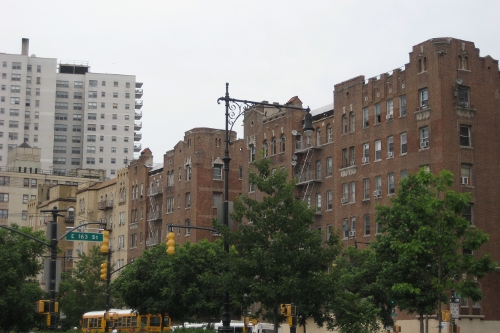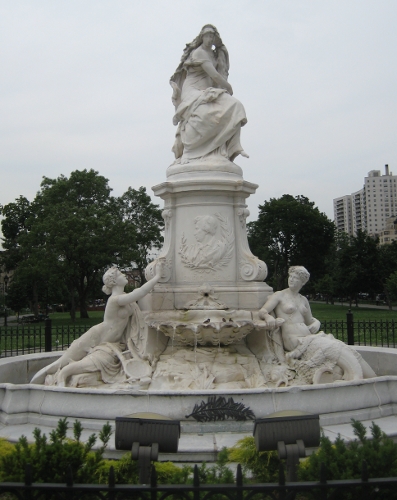
Vor dem Besuch in der Bronx haben wir ja ähnlich gezittert, wie vor dem in Harlem 😉 – und dann war das auch noch am gleichen Tag! Aber, oh Wunder: wir haben uns auf den Grand Concourse konzentriert, einer den Champs Elysées nacheifernden Prachtstraße, die uns erneut die Architektur des Art Déco näherbrachte.
The thought of touring the Bronx was about as scary as that of Harlem 😉 – and we even did it on the same day! But, would you believe it: we concentrated on the Grand Concourse, a fancy boulevard which was modeled on the Champs Elysées in Paris and was all about Art Déco.
Zum Baubeginn 1894 war dort ja sozusagen grüne Wiese und der Boulevard konnte noch großzügiger gestaltet werden, als das französische Vorbild: er ist 6km lang und bis zu 55m breit. 1909 wurde er dann für den Verkehr geöffnet und ein Bauboom setzte ein, der durch die Eröffnung der U-Bahn 1917 weiter in Schwung kam. Unter den ca. 300 Appartmenthäusern gibt es einige der bedeutensten Beispiele des Art Déco in den USA zu sehen – aber irgendwie sprang der Funke bei mir trotz wunderbarer Mosaike wie an der Außenwand unten nicht über.
Construction started in 1894 and as this area was practically out in the countryside at the time, there was room to create a boulevard that surpassed even the French example it was modeled after: it is 6km/4 miles long and up to 55m/180 feet wide. It was opened to traffic in 1909 and initiated a housing boom which was further intensified after the opening of a subway station close by in 1917. Among the approximately 300 apartment buildings along the Grand Consourse there are some of the most exquisite examples of Art Déco in the US. But somehow it didn’t ignite a spark for me, despite gorgeous mosaics on the walls of houses like the one below.
Vielleicht war es der graue Himmel oder aber die paar Geschichtsfetzen, die man als gemeiner Mitteleuropäer im Zusammenhang mit der Bronx im Kopf hat. Nach einem extremen Bevölkerungszuwachs Anfang des 20. Jahrhunderts (1900: 200.000 Einwohner, 1929: 1,3 Millionen), verursacht durch das erste „Überschwappen“ von hauptsächlich italienischer, irischer und jüdischer Bevölkerung aus Manhattan, erlebte das Stadtviertel zwischen 1950 und 1980 einen Niedergang.
Maybe it was the gray sky or those few isolated facts the common central European has heard about the Bronx. It underwent a breathtaking population growth at the start of the 20th century (1900: 200,000 inhabitants, 1929: 1.3 million) which was caused by the first population spillover from Manhattan of mainly Italian, Irish and Jewish backgrounds. The decline of the borough started in the 1950s and went through about 1980.
Besonders die South Bronx war davon betroffen und ist durch Unruhen in den 1970er und 80er Jahren und den damit verbundenen großflächigen Bränden zu trauriger Berühmtheit gelangt. Bis heute ist nicht klar, ob das Abfackeln ganzer Straßenzüge nicht (auch) durch die Eigentümer gestartet wurde, deren Mieteinnahmen unter die zu zahlende Grundsteuer gefallen waren… und die sich vielleicht des Problems durch eine Zahlung der Versicherung entledigen wollten. Heute ist der Stadtteil stark differenziert. Während im Norden gehobene Wohngegenden zu finden sind, bleibt der Süden eine Problemzone. Ob die Bevölkerung tatsächlich näherungsweise 10% weiß, 50% Hispanic, 30% schwarz und 10% asiatisch ist, habe ich an einem „Klingelschild“ festzustellen versucht:
The South Bronx in particular was affected by this and has become notorious for the riots of the 1970s and 80s and the large fires that it experienced during that time. To this day it is unclear how the fires started. One theory is that landlords did it as at some point property tax exceeded incomes… and maybe this was a way of solving that problem – getting an insurance payment at least. Today there are huge differences within the Bronx. While a more affluent population lives in the North, the South remains a problem area. I’ve tried to verify whether the population really is approximately 10% White, 50% Hispanic, 30% African-American and 10% Asian by analyzing a doorbell panel:
Nehmen wir mal, der besseren Leserlichkeit wegen, die mittlere Spalte: Garcia – Guzman – Guzman – Hall-W. – Harris – Harrison – Hereaux – Hernendez – Hernendez – Holmes – Hunt – Hurtado – Iglesias – Jacksin – Janvier – Jones – Jones – Johnson – Kaba – Madera – Maldonado – Martnez – Marte – Martines – Mbguere – Mendez – Miller – Moran – Morgan – Mullins – Muniz – Ngao – Nyampong – Nyantang. 34 Parteien, davon mit großer Wahrscheinlichkeit 15 mit hispanischem Hintergrund. Das sind knapp 50%. Bei den letzten dreien vermute ich asiatischen Hintergrund… knapp 10%. Kann man bei Kaba vielleicht auf die um den Grand Concourse konzentrierte ghanaische Community tippen? Ist Jacksin ein Tippfehler? Fragen über Fragen…
Let’s have a look at the second column, just for the sake of somewhat enhanced legibility: Garcia – Guzman – Guzman – Hall-W. – Harris – Harrison – Hereaux – Hernendez – Hernendez – Holmes – Hunt – Hurtado – Iglesias – Jacksin – Janvier – Jones – Jones – Johnson – Kaba – Madera – Maldonado – Martnez – Marte – Martines – Mbguere – Mendez – Miller – Moran – Morgan – Mullins – Muniz – Ngao – Nyampong – Nyantang. 34 parties, 15 of which are very likely to have a Hispanic background which is a little less than 50%. The last three have an Asian ring to me – a little less than 10%. Could Kaba be a member of the Ghanaian community that is said to be concentrated on Grand Concourse? Is Jacksin a typo? Questions galore…
Aber vielleicht konnte ich mich ja auch gar nicht so recht auf Art Déco konzentrieren, weil der Ausgangspunkt für unsere Erkundung der Bronx ein Brunnen im Joyce Kilmer Park war. Die sog. Loreley Fountain. Oder auch… das Heinrich-Heine-Denkmal. Ja, ein Heine-Denkmal in der Bronx. Die wenigsten New Yorker kennen diesen Brunnen und ob überhaupt einer weiß, wer Heinrich Heine ist bzw. war…?
But maybe there is a whole other reason that distracted me from all the Art déco. We started our walk on Grand Concourse at a fountain in Joyce Kilmer Park. The so-called Loreley Fountain which is a monument to Heinrich Heine. Now, how many New Yorkers know that this fountain exists? And how many know who Heinrich Heine is or rather was…? You can’t find all that much English language information on it when you google… but it does have a Facebook page! Though also in German and „liked“ by two people so far 😉 And for the record: he was a German poet!
Das Denkmal wurde 1897 durch den Bildhauer Ernst Herter fertiggestellt, der es zum 100. Geburtstag des Dichters dessen Geburtsstadt Düsseldorf anbot. Dort jedoch entschied man sich, dass einem Juden kein Denkmal zu setzen sei (seit 1965 haben sie immerhin eine Uni in seinem Namen – also zumindest lernfähig). Dies wiederum kam der deutsch-amerikanischen Gemeinde zu Ohren, die das Denkmal nach New York holte und dort 1899 errichtete. Offensichtlich ist es ein Vertreter dieser Community, der die Geschichte hier nochmal referiert und außerdem Die Loreley zum besten gibt:
The monument was finished in 1897 by sculptor Ernst Herter who offered it to Heine’s native city of Düsseldorf on the occasion of the poet’s 100th birthday. The city declined as nobody wanted to erect a monument for a Jew (today they have Heinrich Heine University, established in 1965, so we can at least state that they do learn. After a while.) The German-American community heard about this and decided that New York was a great place for the monument where it was erected in 1899. I assume it’s a representative of that community who gives us all the details of it and then recites the poem The Loreley in the (German language) video below:
Zum Abschluss noch dieses Foto aus den Roosevelt Gardens, einer Art Gated Community in der Bronx, wo wir uns mal kurz im beschaulichen Innenhof umsehen durften.
Before I sign off for today, there’s one more picture from Roosevelt Gardens, a gated community in the Bronx, where we were allowed to have a short break in their serene courtyard.
Bis bald!
Take care!
Barbara







